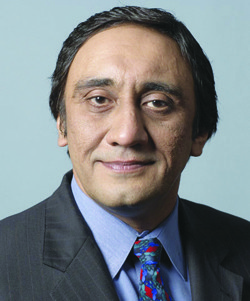Derivatives stalwart CME Group has a couple overriding goals for 2013: capture OTC clearing business that’s coming into play as a result of Dodd-Frank regulation, and continue to expand globally.
The Chicago-based company will proceed on both fronts with the same ethos that has helped grow the business to $2.7 billion in annual revenue.
“A strong focus on serving client needs is the underlying mantra and a common theme across all of our activities, both in the U.S. and around the world,” said CME Chief Executive Phupinder Gill.
 Phupinder Gill, chief executive of CME Group
Phupinder Gill, chief executive of CME Group
CME, which provides a venue for trades in equity indices, foreign exchange, interest rates, agricultural commodities, energy and metals products, has grown both organically and via acquisition. “Our merging with (Chicago Board of Trade) in 2007 brought not only cost efficiency and margin efficiency, but also product-innovation opportunities,” Gill told Markets Media. “And bringing in the New York Mercantile Exchange in 2008 combined all six asset classes onto a single global platform.”
Gill noted that 2012 was a difficult year broadly across markets and the economy. CME’s volume of interest-rate contracts declined but less than at other exchanges, Gill noted, due to the exchange company’s innovation in Treasury curve and Eurodollar products, which yielded about 300,000 additional contracts per day in volume.
“For clients, collateral efficiency was the name of the game in 2012,” Gill said. “For us, it’s about figuring out what clients want and need and delivering solutions in a capital-efficient way.”
The Dodd-Frank Wall Street Reform and Consumer Protection Act stands to buoy the exchange sector by bringing trades that now transact privately onto exchanges, and requiring those trades to be cleared. “Dodd-Frank’s impact is significant in terms of what market participants will need, which is the safest and most capital-efficient way to transact business,” Gill said. “In clearing, where swaps are required to be cleared, CME is the only platform offering margin efficiencies and capital efficiencies against all six asset classes, beginning with fixed income.”
Margin offset savings can be as high as 85-90% depending on the portfolio, Gill said.
Outside the U.S., where trading volumes are expanding faster, CME is expanding its reach. “We’ve applied to the (Financial Services Authority) to start a London-based exchange,” Gill said. “This is a regional exchange focused on building our customer base throughout Europe, and reaching into Asia.”
“We have also expanded our global alliances,” Gill continued. “For example, our strategic alliance with the Bank of China allows us to explore expanded collateral opportunities for our Asian client base and more Bank of China operations in New York and London. Given our presence in the U.S. and U.K., pursuing opportunities potentially involving a Chinese client base trading CME products makes an enormous amount of sense.”
CME recently furthered its cross-listing joint venture with Brazil’s BM&F Bovespa, and also finalized a joint venture with McGraw-Hill Cos. to offer S&P Dow Jones indices.
“On risk management, we have rolled out several risk-management models for our client base and also rolled out tools to understand the true impact of Dodd-Frank on their trading activities,” Gill said.
“A strong focus on serving client needs is the underlying mantra and a common theme across all of our activities, both in the U.S. and around the world.” CME Chief Executive Phupinder Gill
“Currently if clients trade on CME and also clear OTC business, they have separate sets of books—in a cleared world there will be issues with that such as what is the capital impact of cleared swaps and what’s the most capital-efficient route,” he said. “CME developed an ‘Optimizer’ tool that allows clients to examine on their own what clearing at CME and the resulting margin offsets would mean for their portfolio, and by extension providing them with the most capital-efficient way of putting positions on their books.”
For clients who don’t trade enough swaps for clearing, CME offers deliverable swaps futures. “We’ve seen interest and excitement about this—usually we may have 50 to 75 clients participate in an event around a product launch, this time we had 900 clients signed on for a webinar about deliverable swaps futures,” Gill said. “There were a lot of technical and detail-oriented questions, which from our perspective was highly encouraging.”














